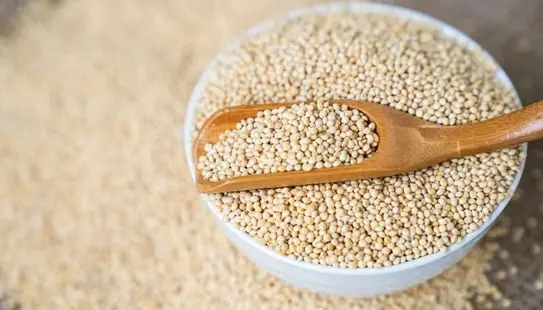Among the vast agricultural practices in India, millets have now come up as monumental crops that can withstand challenges and provide sustainable solutions to ensure food security and nutritional diets. As of 2024, a few states in India are leading in the production of millets thereby adding value to the agriculture profile of India. Successful cultivation of millet in these top-producing states signifies more than only an economic contribution but also their step toward enhancing food secure and nutritional well-being. Millets, known for their natural resilience, adaptability and being a repository of nutritional-richness, will equip sustainable agriculture as it seeks to address the dual challenges of feeding a growing population and the need for diverse dietary experiences. Let’s now dive into the top five states that are the vanguards of millet cultivation.
Largest Millets Producing States In India

1. Rajasthan: The Millet Leader with a 27% Share
Rajasthan, a resilient area, grows millets. Rajasthan is India’s leading millet producer with 27%. Millet output has increased thanks to the state’s agricultural knowledge and novel farming practices. Millets become buddies when they grow in arid regions. Innovative agriculture made Rajasthan’s millet successful. State agro-innovations include climate-resilient millet and water management. Rajasthan illustrates how desert agriculture may survive. This success story highlights the state’s agricultural innovation commitment. Rajasthan’s climate-resilient millet cultivars and water-efficient methods show its dedication to sustainable agriculture.
- Also Read: Highest Maize Producing States In India
2. Maharashtra: Nurturing Millet Growth with a 15% Share
Agro-climatic zones of Maharashtra make it the second-highest millet producer, contributing 15% to national output. Jalgaon, Ahmednagar, and Beed produce millet, reflecting the state’s dedication to sustainable agriculture. Modern agriculture policies and technology help Maharashtra’s farmers grow millet. Millets thrive in Maharashtra’s climates, as seen by its contribution. Maharashtra’s crops demonstrate its sustainable agricultural vision. The focus on technological integration and farmer empowerment indicates the commitment to meeting millet production needs and improving agricultural communities. Maharashtra’s millet-woven agricultural tapestry reveals how ancestral wisdom and modern innovation influence agriculture.
3. Uttar Pradesh: Cultivating Millet Prosperity at 14%
The most populous state, Uttar Pradesh, produces 14% of India’s millet, ranking third. Excellent agricultural plains make Sitapur, Lakhimpur Kheri, and Shahjahanpur good for millets. Uttar Pradesh’s agricultural growth, infrastructure, and farmer aid have increased millet output. Uttar Pradesh’s fertile soils and broad landscapes support millet cultivation, improving food security and economic growth. Millets have empowered Uttar Pradesh farmers and improved food security. Food diversity and farmer income have increased thanks to the state’s millet-based agriculture system development.
4. Karnataka: Navigating Agro-Climatic Diversity with a 13% Share
Karnataka, famed for its agricultural diversity, produces 13% of national millet. Millet cultivation has increased in Gulbarga, Hassan, and Mandya, displaying Karnataka’s agricultural expertise. Karnataka’s millet powerhouse status is attributed to its farmers’ adaptability and innovation, who have gladly adopted new agricultural methods and irrigation technology. Millets adapt well to Karnataka’s agro-climatic zones. Karnataka’s millet output is due to innovative farming. Mixing millet with other crops and using agro-ecology has given the state a sustainable and resilient approach. This method enhances soil health and protects agro-biodiversity, demonstrating Karnataka’s holistic approach to agricultural riches.
5. Madhya Pradesh: Sowing Millet Seeds for a Bountiful Harvest at 8%
Madhya Pradesh proudly produces 8% of India’s millet, ranking sixth. The favorable climate and extensive agricultural areas of Dewas, Hoshangabad, and Harda support millet cultivation. While known as the “Heart of India,” Madhya Pradesh’s agricultural environment prioritizes farmer welfare. Due to ample arable land, good climate, and government support, millet farming has increased. Farmer-centric policies and resilience-driven agriculture boost Madhya Pradesh’s millet yield. Agriculture policies of Madhya Pradesh focus farmer development. High-quality seeds, effective irrigation, and strong market relations are state priorities. This comprehensive method has helped Madhya Pradesh millet cultivation.
Millets FAQ
Q1. Which state has the highest consumption of millets in India?
Ans: Assam and Bihar consume the smallest millets in India, 18.82 and 18.69 kg/hsh/m. A significant intake of micro millets in rural parts of these states shows their relevance in their diets. Assam and Bihar consume more than others. The significant consumption of little millets in these two states reveals their cultural and gastronomic value, particularly in rural areas. Other Indian states use less than 10 kg/hsh/m. This stark contrast reveals regional diets and modest millet dependency. States with consumption below 10 kg/hsh/m value small millets less than Assam and Bihar.
Q2. What is the historical importance of millets in our country?
Ans: Millets, an early crop, date back to the Indus-Sarasvati civilization (3,300–1300 BCE). Numerous studies show that millets have nourished this ancient culture for millennia. Ancient grains remain essential in current cooking. In Asia and Africa, half the population eats millets. Millets’ richness is seen by their nearly 6,000 varieties. This variety of millet cultivars displays its adaptability to many climates and agricultural conditions. Millets nourish communities globally in numerous settings. Indus-Sarasvati culture ate millet, demonstrating its longtime role in human diets. Millets feed millions and provide food security in traditional millets-growing nations.
Q3. Why Government is promoting millets?
Ans: Millets are essential to Indian cuisine, providing nutrition and health. Due to its nutritional value and many benefits, the Indian government has chosen millets to enhance farmers’ income and food security. Millets in government agricultural and nutritional policy are visionary for sustainable farming. Millets can withstand a variety of agroclimatic conditions, making them a good grain alternative. Millets are promoted by the government to provide farmers a regular income and a crop that thrives in varied environments. Millets’ nutritional value aids India’s malnutrition fight and healthy eating initiatives. Millets provide fiber, vitamins, and minerals for a balanced diet. Since the government endorses millets as a safe crop, they may reduce hunger across demographics.
Conclusion
It is thus understood clear that millets are not just crops; they are catalysts of change. From the arid resilience of Rajasthan to the agro-diversity of Karnataka, the uniqueness each state brings to India’s millet narrative is as inspiring as these top millet producing states forging their way. The millet revolution thus stand testament to the agricultural innovation, resilience, and commitment of Indian farmers thereby putting a foundation for a food secure and nutrition-enriched future.

Santosh Kumar is an editor at unfoldstuffs.com and a professional content writer. With years of experience he is passionate for creating engaging, informative and impactful topics.









